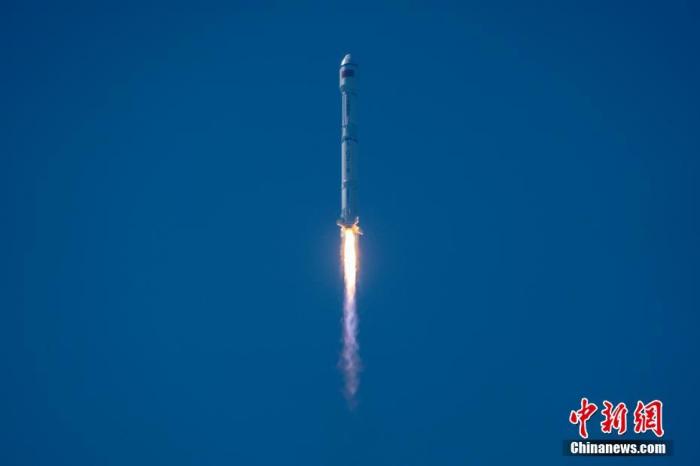China News Agency, Beijing, February 27th (Ma Shuaisha and Wang Bing) On February 27th, the Long March 8 Yao-2 carrier rocket successfully delivered 22 satellites from 7 research and development units in the way of "one arrow and twenty-two stars". into the predetermined orbit, creating the largest number of satellites launched by China with one arrow.
How can so many "passengers" fit in the limited fairing space?
How to make every "passenger" sit comfortably and get off safely and accurately?
The Long March 8 rocket design team adopted a new "three-layer multi-satellite distributor" structure and fully designed the safety of satellite separation.
At 11:06 on February 27, China successfully launched 22 satellites into space using the Long March 8 carrier rocket at the Wenchang Space Launch Site, setting a new record for China with multiple satellites with one arrow.
Photo by China News Agency reporter Luo Yunfei
The three-tier "seats" and "passengers" are in their respective positions and smoothly "get on the bus"
The diameter of the fairing of the Long March 8 Yao-2 launch vehicle is 4.2 meters. In a limited space, to launch 22 satellites with one arrow, the first step is to rationally arrange these satellites in the fairing.
Chen Xiaofei, deputy chief designer of the Long March 8 launch vehicle of China Aerospace Science and Technology Corporation, said that the launch of 22 satellites in one rocket has never happened in China.
Since each satellite has a different shape and many satellites are large in size, the design team first considered how to effectively utilize the space envelope in the fairing when it was first laid out.
Combined with the mission requirements, the design team combed the traditional satellite structure, and finally designed a new "three-layer multi-satellite distributor" to provide "passengers" with three layers of "seats".
The "three-layer multi-star distributor" is composed of a conical bracket, a central bearing cylinder and a disc platform from bottom to top.
Among them, the conical bracket carries 2 satellites, the central bearing tube carries 14 satellites, and the disc platform carries 6 satellites, perfectly fitting 22 satellites into the fairing.
Although it is a brand new structure, there are some familiar "faces" in it.
Yu Long, the general deputy chief designer of the Long March 8 launch vehicle, pointed out that the conical support at the bottom of the multi-satellite distributor follows the structure of the Long March 8 Yao-1 launch vehicle; Use the space of the fairing to hang more satellites on the side wall.
"For some satellites with larger diameters that are not suitable for side-mounted, the design team has designed a new disk platform above the central bearing cylinder, which makes the installation and operation of large-diameter satellites simpler, and there are no other satellites to interfere in the separation direction. "Yu Long said.
At 11:06 on February 27, China successfully launched 22 satellites into space using the Long March 8 carrier rocket at the Wenchang Space Launch Site, setting a new record for China with multiple satellites with one arrow.
Photo by China News Agency reporter Luo Yunfei
Double consideration, it is safer to "get off" in batches
Will there be a collision when the 22 satellites separate and enter their intended orbits?
With the "seats", the satellites are smoothly installed in the fairing, but how can these "passengers" be able to "get off" safely and accurately?
The first consideration is the safety of satellite near-field separation.
Yu Long said that the satellite has to leave the arrow body after it reaches the sky. During this process, there will be some deviations in the power source and unlocking method of the satellite. It is not the static installation position in the imagination, but it must be within this range during the separation process. Don't wobble.
Sometimes these small deviations will reduce the distance between satellites and threaten the safety of the rocket body.
According to the different separation mechanisms of the satellites, the design team carried out multiple rounds of simulation calculations for all the rocket bodies and satellite deviations based on the actual satellite layout positions, so that a certain dynamic gap in the near-field separation process between the satellites was retained to ensure the near-field separation. safety.
The greater the number of satellites, the greater the risk of collision in orbit after separation. Therefore, the safety of far-field separation is also a key consideration for designers.
Li Jinglin, the orbital designer of the Long March 8 launch vehicle, pointed out that the separation speed, separation direction and separation sequence are the key factors affecting the subsequent trajectory of the satellite.
However, with such a large number of satellites this time, it is a big challenge for designers to stagger the 22 satellites in the limited external separation orbits to avoid mutual interference between the satellites.
22 satellites plus a rocket final stage are 23 separate bodies. In order to ensure the safety of separation from each other, the design team calculated and analyzed the orbital parameters of each satellite to determine the relative distance between the 23 separate bodies. Carry out long-term simulation, observation and assessment, and design the separation plan according to the satellite layout. Finally, 12 separation actions are taken, and 22 satellites are gradually separated in sequence. The adjustment of the separation direction of each satellite ensures the safety of the near and far fields of each satellite, and allows the 22 satellites to "get off" with peace of mind.
(over)

